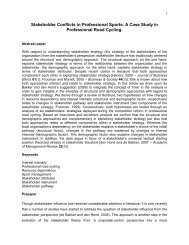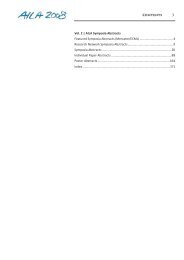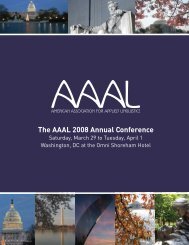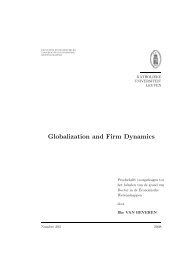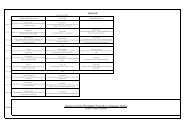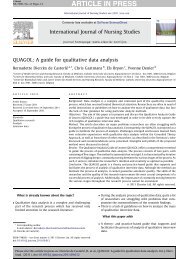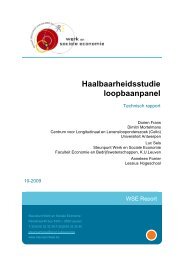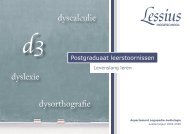The role of implicit attitudes towards food and ... - ResearchGate
The role of implicit attitudes towards food and ... - ResearchGate
The role of implicit attitudes towards food and ... - ResearchGate
Create successful ePaper yourself
Turn your PDF publications into a flip-book with our unique Google optimized e-Paper software.
46 M. Craeynest et al. / Eating Behaviors 9 (2008) 41–51<br />
3.3. Mean evolution in <strong>implicit</strong> <strong>and</strong> self-reported <strong>attitudes</strong> during treatment<br />
3.3.1. Implicit <strong>attitudes</strong><br />
Physical activity. A 3 (time: T1 vs. T2 vs. T3) ×3 (word category: sedentary activities vs. moderate intense PA vs.<br />
high intense PA) ×2 (extrinsic response valence: positive vs. negative) Repeated Measures ANOVA only revealed a<br />
main effect <strong>of</strong> time on the reaction times, F(2, 17)=10.22, pb.01, indicating that the participants reacted faster on the<br />
persecuting test moments (respectively T1: M=858 ms, SD=47 ms; T2: M=733 ms, SD=34 ms; T3: M=674 ms,<br />
SD=29 ms). No effects were found for word category, all Fsb1.82, <strong>and</strong> extrinsic response valence, all Fsb2.56. This<br />
indicated that the participants remained neutral <strong>towards</strong> sedentary activities, moderate <strong>and</strong> intense PA. <strong>The</strong> same<br />
3×3×2 ANOVA performed on the percentages <strong>of</strong> errors, showed no significant effects, all Fsb1.35.<br />
Food. Using a 3 (time: T1 vs. T2 vs. T3)×2 (word category: unhealthy vs. healthy <strong>food</strong>) ×2 (extrinsic response<br />
valence: positive vs. negative) Repeated Measures ANOVA, the results only revealed a main effect for time, F(2, 17)=<br />
416.88, pb.001. This indicated that the participants react faster on the persecuting test moments (respectively T1:<br />
M=868 ms, SD=59 ms; T2: M=724 ms, SD=38 ms; T3: M=694 ms, SD=23 ms). No effects were found for word<br />
category <strong>and</strong> extrinsic response valence, all Fsb3.23. <strong>The</strong> same 4×2×2 ANOVA was conducted on the percentages <strong>of</strong><br />
errors, however no significant effects were found, all Fsb2.10. Implicit <strong>food</strong> <strong>and</strong> physical activity associations are<br />
presented in Table 1.<br />
3.3.2. Self-reported <strong>attitudes</strong><br />
Physical activity. A 3 (time: T1 vs. T2 vs. T3)×3 (word category: sedentary activities vs. moderate intense vs. high<br />
intense PA) Repeated Measures ANOVA showed a main effect <strong>of</strong> time, F(2, 17)=5.93, pb.05, indicating that the<br />
participants became more positive on the successive measure moments (T1: M=1.47, SD=0.14; T2: M=1.81,<br />
SD=0.14; T3: M=2.01, SD=0.11). Also the main effect <strong>of</strong> word category was significant, F(2, 17)=8.16, pb.01.<br />
Post hoc paired t-tests revealed that in general, moderate intense PA (M=2.09, SD=0.50) was rated more positive than<br />
sedentary activities (M=1.68, SD=0.40), t(18) =3.59, pb.01, <strong>and</strong> than high intense PA (M=1.52, SD=0.77), t(18) =<br />
2.78, p b.05. Sedentary activities <strong>and</strong> high intense PA were rated equally, tb1. <strong>The</strong> interaction effect <strong>of</strong> time <strong>and</strong> word<br />
category was not significant, Fb1.<br />
Food. A 3 (time: T1 vs. T2 vs. T3) ×2 (word category: unhealthy vs. healthy <strong>food</strong>) ANOVAwith Repeated Measures<br />
showed a main effect <strong>of</strong> word category, F(1, 17)=6.46, pb.05. A post hoc paired t-test revealed that, in general, the<br />
participants were more positive <strong>towards</strong> healthy (M=1.97, SD=0.69) than <strong>towards</strong> unhealthy <strong>food</strong> (M=0.91,<br />
SD=1.51), t(18)=2.38, pb.05. <strong>The</strong> main effect <strong>of</strong> time <strong>and</strong> the interaction effect <strong>of</strong> time <strong>and</strong> word category were not<br />
significant, both Fsb1. Table 2 describes the mean self-reported <strong>attitudes</strong> for the persecuting test moments.<br />
3.4. Prediction <strong>of</strong> ABMI change during treatment by attitudinal change during treatment<br />
To investigate whether attitudinal changes could explain the variance in ABMI change, we conducted st<strong>and</strong>ard<br />
multiple regression analyses. Because <strong>of</strong> the small sample size, the predictive power <strong>of</strong> the several attitudinal change<br />
variables on ABMI change was examined separately for <strong>implicit</strong> <strong>and</strong> self-reported <strong>attitudes</strong> <strong>and</strong> for <strong>food</strong> <strong>and</strong> physical<br />
activity, resulting in four different models. In each model, baseline ABMI, age <strong>and</strong> sex (entered as a dummy variable:<br />
girl=0; boy=1) were entered as covariates. ABMI <strong>and</strong> attitudinal change during treatment were calculated by<br />
respectively subtracting the ABMI <strong>and</strong> attitudinal scores at T1 from T2.<br />
3.4.1. Implicit <strong>attitudes</strong> <strong>towards</strong> physical activity<br />
In a first model, ABMI change during treatment was the dependent variable, <strong>and</strong> the change in attitude <strong>towards</strong><br />
sedentary activity (RT), <strong>towards</strong> moderate intense PA (RT), <strong>towards</strong> high intense PA (RT), <strong>towards</strong> sedentary activity<br />
(PE), <strong>towards</strong> moderate intense PA (PE), <strong>towards</strong> high intense PA (PE), baseline ABMI, age <strong>and</strong> sex were entered as<br />
independent variables. <strong>The</strong> model accounted for 73% <strong>of</strong> the variance, F(9, 18)=6.51, pb.01. Attitudinal change<br />
<strong>towards</strong> high intense PA (RT) was a significant predictor, adjusted for age, sex <strong>and</strong> baseline ABMI, β=.51; t(18) =2.91,<br />
pb.05. Remarkably, this indicated that a decrease in overweight was related to a more negative attitude <strong>towards</strong> high<br />
intense PA at the end <strong>of</strong> the treatment. Further, also baseline ABMI, β = −.57; t(18)=4.03, p b.01, <strong>and</strong> sex, β =.64;<br />
t(18)=4.12, p b.01, were significant predictors. <strong>The</strong> first indicated that decrease in overweight was related to a<br />
higher baseline ABMI, <strong>and</strong> the latter indicated that girls had a higher probability to decrease in overweight than




